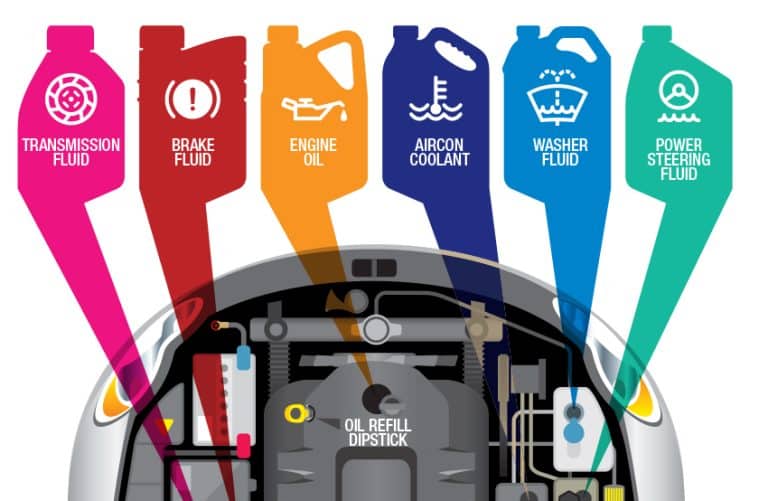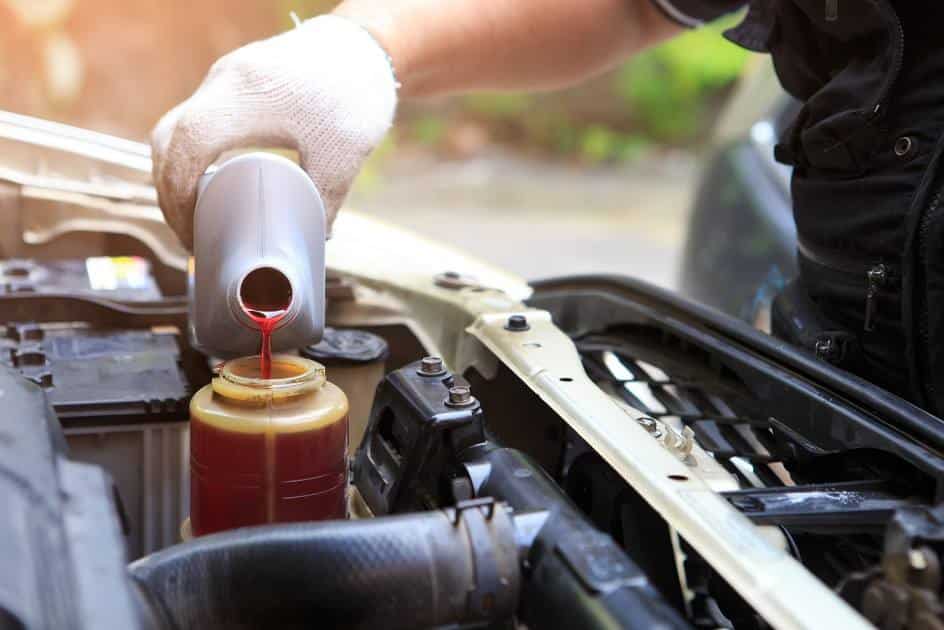Your car will require a considerable amount of maintenance to ensure its efficient performance. The most basic thing that a car owner can do to keep their car running smoothly is to maintain the fluids.
Fluids play a huge role in almost every facet of your car, including fuel economy and longevity. Keeping them at the proper level will help your car last longer and drive better, something we can all get behind. We will provide an overview of the most important car fluids, their function, and tips on how to check car fluids.

Engine Oil
The main lubricant vehicles use is engine oil. This oil provides proper lubrication of all the moving parts inside an internal combustion engine – to disperse heat and prolong the life of all components. It is essentially the lifeblood of the engine, and without it, serious damage can be caused in a very short amount of time.
That’s why it’s important to bring your car in for an oil change every 3,000 miles (5,000 for synthetic oil). While the mechanic checks your oil, have him check and top off your other fluids.
If you are a do-it-yourselfer, make sure the car is on a level surface such as a driveway or parking lot, lift the hood of the car, and locate two specific places: 1. the dipstick and 2. where you replenish the oil. Remove the dipstick and wipe clean then insert the clean dipstick back in then remove again. Do this a few times, checking where the oil level is and wiping clean each time.
Transmission Fluid
Transmission fluid ensures that your car runs smoothly. Checking the transmission fluid is the same as checking the engine oil, the only difference is that you have to check it while the engine is running. Instead of checking the volume, you will need to check the quality.
To inspect the quality, it’s important to pay attention to the color of the fluid. If your fluid is healthy, it should have a reddish-pink color; if it’s getting to the point of needing replacement, it will be brownish-red. If the fluid is dark brown or black, then it’s quite possible that you will be replacing more than just your fluid.
Dark fluid with a burnt smell is bad news; in the worst case, you may even find fine metal shavings in the fluid as well. Both of those symptoms point to possible damage of the internal components. of the transmission.
Check this monthly; replacing it should be conducted between 50,000 to 10,000 miles.
Coolant
During the hot summer months, coolant (antifreeze) keeps the engine cool and prevents it from freezing during the winter. Also, the coolant helps prevent corrosion, foam, and deposits from forming.
Antifreeze deteriorates over time and in newer cars should be tested after 50,000 miles. Even if the cooling system seems to be working, test for acidity as well as freezing and boiling protection, and also check for signs of rust and leaks. Coolant is one of the more important fluids to check in the car.
Checking should be done twice a year, and it is recommended to replace it every 2 or 3 years.
Brake Fluid
When you step on the brake pedal, it activates the brake plunger, within the master cylinder. The pressure pushes the brake fluid out of its reservoir inside the brake lines, which causes the brake pads to slow your car.
As your brake pads wear, your brake fluid level usually goes down. If it falls below the minimum indicator, add some fluid and also have your brakes checked. The same goes for your power steering fluid, which allows you to easily turn your steering wheel; without power steering, it would be extremely stiff.
Brown color means that it is time for you to replace them. Replacing should be done every 2 years.
Power Steering
Power steering fluid lubricates your car’s power steering system, providing smooth operation. If you are low on power steering fluid, your car’s steering wheel will have a tendency to judder and shift and will be hard to operate.
In case it is low, you may hear a ‘creaking’ sound when you turn the steering wheel. You can check it simply by looking at your reservoir in the power steering system. In case it is low, you need to take them to an auto shop to look for any leak. Replacing should be done starting from 50,000 miles.
Bonus: Windshield Washer Fluid
Windshield washer fluid is often brightly colored and, of all the car fluids, adding windshield washer fluid is perhaps the easiest. The cap usually has a symbol of a windshield wiper on it. If the fluid level is empty or low, pour washer fluid into the reservoir, fill it up to the top, and then close the cap. Having a clean windshield ensures safety and visibility while traveling on the road
Now that you know what car fluids are in a car, you can be proactive about checking them. If you don’t have the time or interest, the other option is taking your car in on a regular basis to your local auto shop and letting a professional inspect your vehicle and ensure your car fluids are at their proper levels.
Having the fluid of your car regularly checked will ensure that it will last longer. Let the professionals at Auto King handle your fluid maintenance, and we will guarantee that your car will run smoothly and efficiently.





